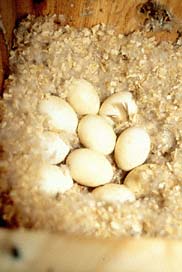Have you noticed a duck nesting in a tree?
You’ve probably just seen a Wood Duck
By eNature
The idea of a duck in a tree may raise some eyebrows. The idea of a duck in the backyard may raise a few more.
Yet there are mallards in backyards across the continent incubating eggs right now. There are also Wood Ducks in backyards, particularly in the East, sitting on eggs—but they’re 20 to 30 feet above the ground in tree cavities or duck houses.
A Nest in the Sky
Though Wood Ducks spend most of their lives on water like other ducks, when it comes to nesting, they take to the trees. And the hens are most at home nesting near where they themselves were hatched.
In the spring, a hen Wood Duck leads her beautiful, multi-colored mate back to the place where she was hatched. Together, they explore tree cavities and large birdhouses for a suitable nesting site. The hen then lays an egg a day, for 10 to 12 days, before beginning her incubation of the eggs for another 28 days. Meanwhile, the drake remains attentive, accompanying her on feeding forays twice a day.
That First Step Is A Doozy!
On the day when all the eggs hatch, the hen coaxes the fuzzy ducklings to jump out of the nest, sometimes from a great height—it’s a noisy, dramatic sight! Then she leads her family to water, where they spend the balance of the summer growing up.
Watching a pair of Wood Ducks attend a nest for a month is wonderful, but to witness the ducklings jumping from the nest, two and three at a time, is something else. So keep your eyes up as you watch for ducklings this spring!
Have you seen Wood Ducks in your neck of the woods? Or any other nesting bird pairs?
We always enjoy your stories!



